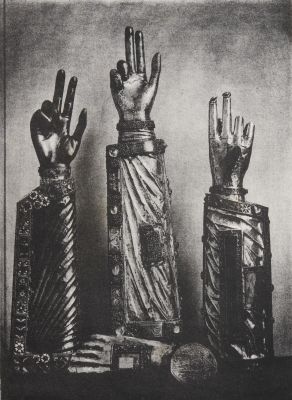
Title
10. Statuette en Albatre de la Sainte Vierge / 11. Statuette en Marbre de la Sainte ViergeArtist
Maes, Joseph (Belgian, 1838-1908)Publication
Instrumenta Ecclesiastica: Choix D'objets D'art Religieux Du Moyen-Âge Et De La RenaissanceDate
1864Process
PhotolithographAtelier
Simonau & TooveyImage Size
23 x 15.5 cm
On December 21, 1860, the lithographic printing firm of Gustave Simonau and William Toovey obtained the license in Belgium for the photolithographic process invented by Eduard Asser in 1858. In conjunction with Asser, William Toovey improved the process and exhibited specimens in 1861, 1863 and 1864 at the French Society of Photography, which was reported in the French Press…We saw in the workshops of MM Simoneau and Toovey, very remarkable essays of photographs on stone. When you operate from an engraving, the results could not be more satisfactory. Photographs from nature come much more difficultly; however, we do not despair of finding more perfect processes. [1]
In July of 1863, Toovey filed a patent for his improvements in photolithography, photozincography and photographic etching processes. At this time, around 1863, Spa Et Ses Environs Photolithographies par Simonau et Toovey was published containing 13 photolithographs of various sites of the city of Spa, from photographs by Doneux, published by G. Engel. Soon Simonau & Toovey began to collaborate with the publisher and art historian William Henry James Weale (1832-1917), all three sharing an interest in medieval art. Together they published, Le Beffroi. Le Beffroi is mainly illustrated with Simonau et Toovey photolithographs and is undoubtedly the first journal to use them in such a systematic way.
In 1864 Weale organized a major exhibition on ecclesiastical art, the most ambitious event ever conceived on the subject. He planned a photographic catalog of it by photographer and photographic printer Joseph Maes (1838-1908), then active outside Brussels. A first edition illustrated with tipped in albumen prints appeared under the title Album des objets d ’art religieux du Moyen Age et de la Renaissance exposés à Malines en 1864, printed by Maes the same year, in an edition of 52 printed issues. A second edition was published in 1866 under the title Instrumenta ecclesiastica. Choix d ’objets d ’art religieux du moyen âge et de la renaissance exposés à Malines en septembre 1864. 57 planches photolitographiées par Simonau et Toovey (Procédé Toovey) and contained the same images, but this time with photolithographs. Instrumenta ecclesiastica was sold for the much more affordable price of 60 francs.
Simonau & Toovey also experiment with heliogravure (engraving on glass by biting hydrofluoric acid) collaborating with many artists, including Félicien Rops (1833 1898) for the set of 24 sketches of the Salon de peinture et sculpture of 1866.
By the late 1860s, photolithography began to face criticism, especially concerning the poor rendering of halftones and the difficulty of the process. The market gradually began to lose its importance. To make matters worse, around 1868, Charles Claesen (1829-1887) opened a competitive enterprise nearby which diluted Simonau & Toovey’s share of the waning market. In 1869, Simonau and Toovey obtained the rights from W.B. Woodbury for his process and the firm released a series of woodburytype reproductions of baroque and Renaissance artists. The Woodbury process however required significant equipment and investment and without ensuring the financial return in a country as small as Belgium. In 1870 Simonau died and his widow and brother-in-law took over the firm under the name “Veuve Simonau & Toovey”. William Toovey returned to England between 1871 and 1873 and the photomechanical side of the firm ceased. [2]
References
[1] Meunier, Laurence, Les imprimeurs-lithographes Simonau & Toovey; In Monte Artium Volume 7: Le livre illustré en Belgique / Het geïllustreerde boek in België (1800-1865) Jan 2014
[2] Joseph, Steven F. "Simonau Et Toovey: The Introduction of Photomechanical Printing to Belgium, 1860-1873." Jubilee – 30 Years Eshph / European Society for the History of Photography. Ed. by Anna Auer and Uwe Schögl. (2008): 150-159.
Hanson, David Checklist of photomechanical processes and printing 1825-1910, 2017 p. 137
The Journal of the Photographic Society of London, vol. 12, June 15, 1867





